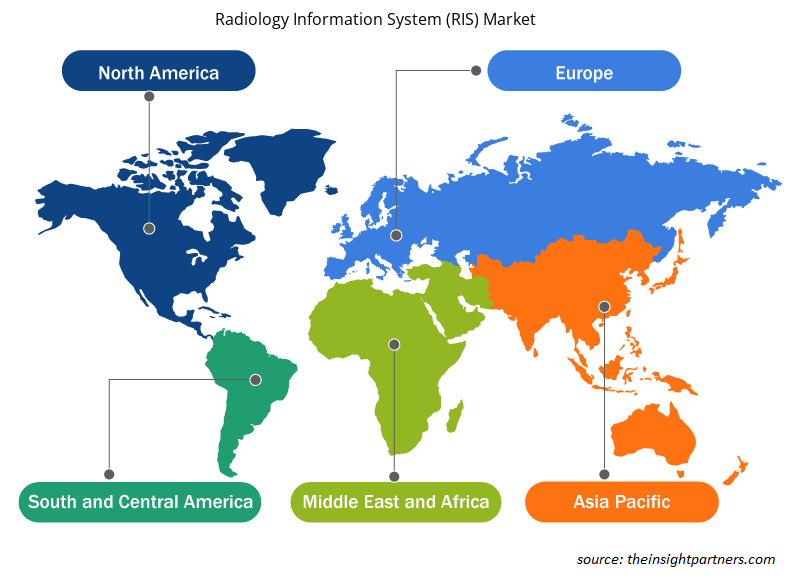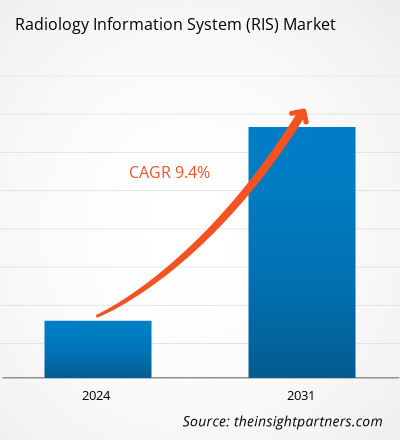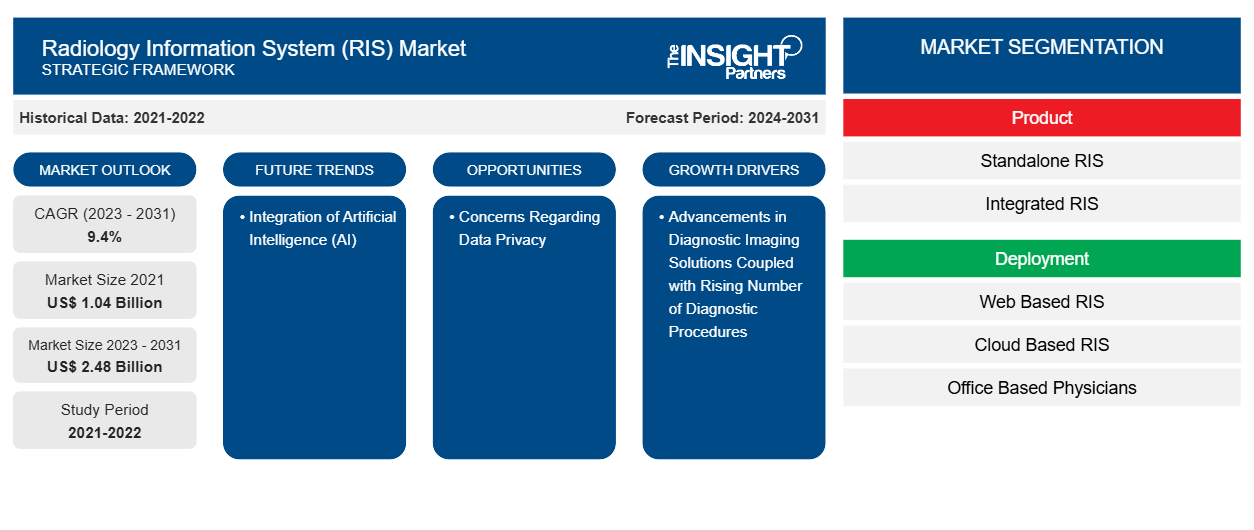2021 年放射信息系统 (RIS) 市场规模为 10.4 亿美元,预计到 2031 年将从 2023 年的 XX 亿美元增至 24.8 亿美元。预计 2023-2031 年市场复合年增长率为 9.4%。放射信息系统 (RIS) 的健康风险较低,在发展中地区的采用率较高,人们对其认识的提高可能仍是放射信息系统 (RIS) 市场的主要趋势。
放射信息系统 (RIS) 市场分析
关键的市场增长因素包括慢性病发病率的上升、医疗信息技术系统的普及以及政府对癌症研究的资助。此外,全球范围内慢性病负担不断加重,再加上人口老龄化加剧,癌症、关节炎、心血管疾病和糖尿病等生活方式相关疾病是导致该市场增长的一些主要因素。预计癌症病例的增加将导致人们更加关注放射学服务,以便进行适当的诊断,这预计将增加对放射学信息系统的需求。癌症等慢性病的增加正在推动对放射学信息系统的需求。然而,高昂的安装成本和缺乏熟练劳动力预计将在研究期间阻碍市场增长。
放射信息系统 (RIS) 市场概况
RIS 是专门的医疗保健软件,旨在管理和简化放射科和影像中心的运营。RIS 存储、管理和分发放射图像、患者信息和相关数据。包括机器学习、深度学习和医疗保健中的 AI 集成在内的持续技术进步将提高放射系统的准确性和效率。此外,对改善患者护理和简化工作流程的综合医疗保健解决方案的需求不断增长,这正导致采用 RIS。政府法规和举措也促进了医疗数据和记录的标准化。它们还为采用医疗保健 IT 服务提供了激励,预计这将对市场增长机会产生积极影响。
定制此报告以满足您的需求
您可以免费定制任何报告,包括本报告的部分内容、国家级分析、Excel 数据包,以及为初创企业和大学提供优惠和折扣
-
获取此报告的关键市场趋势。这个免费样品将包括数据分析,从市场趋势到估计和预测。
放射信息系统 (RIS) 市场驱动因素和机遇
诊断成像解决方案的进步有利于市场
数字成像的引入改变了放射学领域。它催化了从传统胶片成像到数字格式的转变,优化了数据管理,提高了可访问性。数字图像处理也显著提高了图像质量。RIS 允许医护人员为住院和门诊患者预约。放射学已朝着医疗服务中的计算机化管理发展,并满足了放射科和用户之间对经济高效和快速通信的需求。在过去的几年里,医疗保健领域用于诊断目的的成像模式有了各种发展。近年来,数字射线照相术取得了许多进展,包括人工智能辅助 X 射线解释、双能量成像、断层合成、计算机辅助诊断、自动图像拼接和数字移动射线照相术。这些进步提高了图像质量,有助于改善患者护理并实现更好的患者治疗效果。此外,使用数字射线照相术减少了重复成像的需要,具有降低辐射暴露的优势。
新兴经济体医疗 IT 服务应用日益广泛——放射信息系统 (RIS) 市场增长机遇
在全球范围内,放射科服务越来越需要采用技术来满足需求。RIS 的未来在于人工智能 (AI) 和机器学习 (ML) 的使用。人工智能算法可以帮助放射科医生分析图像、检测异常并支持决策。ML 算法可以不断从大量数据中学习并改进诊断和治疗计划。通过互联网和移动技术、远程放射学、人工智能、医学成像信息学的发展以及便携式或移动医学成像设备改善的连接性可以使任何国家的偏远地区都能获得更好的医疗保健和诊断。此外,在发展中国家,随着这些国家正在经历医疗服务作为成熟品牌的国际化,卫生系统正变得更加技术友好。例如,总部位于美国的克利夫兰诊所在阿联酋扩大了市场,总部位于英国的初创公司 Babylon(一款由机器学习和人工智能驱动的初级保健诊断应用程序)进入了中国和卢旺达。
放射信息系统 (RIS) 市场报告细分分析
有助于得出放射信息系统 (RIS) 市场分析的关键部分是产品、部署、组件和最终用户。
- 根据产品,放射信息系统 (RIS) 市场分为独立 RIS 和集成 RIS。2023 年,集成 RIS 部分占据了最大的市场份额,预计同一部分在预测期内的复合年增长率最高。
- 根据部署,市场分为基于 Web 的 RIS、基于云的 RIS 和本地 RIS。2023 年,基于 Web 的 RIS 部分占据了最大的市场份额。然而,基于云的 RIS 部分预计将在 2023-2031 年期间实现最高的复合年增长率。
- 根据组件,放射信息系统 (RIS) 市场分为硬件、软件和服务。2023 年,服务部门占据了最大的市场份额,而软件部门预计在预测期内将实现最高的复合年增长率。
- 就最终用户而言,市场分为办公室医生、医院和紧急医疗服务提供商。2023 年,医院部门占据了最大的市场份额,预计同一部门在预测期内的复合年增长率最高。
放射信息系统 (RIS) 市场份额(按地区)分析
放射信息系统(RIS)市场报告的地理范围主要分为五个地区:北美、亚太、欧洲、中东和非洲、南美/南美和中美。
北美一直主导着放射信息系统 (RIS) 市场。该地区市场需求预计将以显著的速度增长,原因包括政府对医疗基础设施的投资、人们对医学成像的认识不断提高以及实施 RIS 带来的好处等。在美国,该地区拥有大量成像中心、技术进步速度飞快、老年人口不断增长以及对计算机辅助诊断的需求不断增加等因素是该市场增长的一些主要驱动因素。此外,各种公司都致力于开发用于心血管、骨科、牙科和肿瘤诊断成像的先进 RIS 系统,预计这将为市场增长提供增长机会。然而,由于该地区医疗基础设施改善以及消费者采用先进医疗技术的速度加快等因素,该地区医疗信息技术行业将在未来几年实现最高复合年增长率。
放射信息系统 (RIS) 市场区域洞察
Insight Partners 的分析师已详尽解释了预测期内影响放射信息系统 (RIS) 市场的区域趋势和因素。本节还讨论了北美、欧洲、亚太地区、中东和非洲以及南美和中美洲的放射信息系统 (RIS) 市场细分和地理位置。

- 获取放射信息系统 (RIS) 市场的区域特定数据
放射信息系统 (RIS) 市场报告范围
| 报告属性 | 细节 |
|---|---|
| 2021 年市场规模 | 10.4亿美元 |
| 2031 年市场规模 | 24.8亿美元 |
| 全球复合年增长率(2023 - 2031) | 9.4% |
| 史料 | 2021-2022 |
| 预测期 | 2024-2031 |
| 涵盖的领域 |
按产品
|
| 覆盖地区和国家 |
北美
|
| 市场领导者和主要公司简介 |
|
放射信息系统 (RIS) 市场参与者密度:了解其对业务动态的影响
放射信息系统 (RIS) 市场正在快速增长,这得益于最终用户需求的不断增长,而这些需求又源于消费者偏好的不断变化、技术进步以及对产品优势的认识不断提高等因素。随着需求的增加,企业正在扩大其产品范围,进行创新以满足消费者的需求,并利用新兴趋势,从而进一步推动市场增长。
市场参与者密度是指在特定市场或行业内运营的企业或公司的分布情况。它表明在给定市场空间中,相对于其规模或总市场价值,有多少竞争对手(市场参与者)存在。
在放射信息系统 (RIS) 市场运营的主要公司有:
- 荷兰皇家飞利浦公司,
- 西门子医疗股份公司,
- 拜耳公司,
- Cerner 公司,
- 通用电气公司
- 麦克森公司
免责声明:上面列出的公司没有按照任何特定顺序排列。

- 获取放射信息系统 (RIS) 市场顶级关键参与者概览
放射信息系统 (RIS) 市场新闻和最新发展
放射信息系统 (RIS) 市场通过收集一级和二级研究后的定性和定量数据进行评估,其中包括重要的公司出版物、协会数据和数据库。以下是放射信息系统 (RIS) 市场的发展列表:
- 领先的医疗软件提供商 Royal Solutions Group 很高兴宣布扩大与 Concord Technologies 的合作伙伴关系。通过整合 Concord 的 Practical AI 套件中的其他技术,该套件包含尖端的数据处理解决方案,可以轻松扫描打字和手写笔记,然后提取数据并将其集成到工作流程中。这有望改变医疗实践处理订单输入、索引和事先授权的方式。通过自动化这些关键流程,医疗保健专业人员可以专注于患者护理而不是文书工作。(Royal Solutions Group, LLC,新闻稿,2024 年)
- 印度领先的医疗保健提供商之一马尼帕尔医院 (Manipal Hospitals) 已与 FUJIFILM India 达成协议。根据长期协议,马尼帕尔医院将获得由 FUJIFILM India 提供支持的大型图片存档和通信系统 (PACS)。PACS 消除了手动存储、检索和发送敏感信息、胶片和报告的需要。(FUJIFILM India Private Limited,新闻,2023 年)
- PARATUS 收购 IMAGE Information Systems 的多数股权。IMAGE 是全球领先的 PACS 服务提供商,为世界各地的影像中心和医院提供服务。PARATUS 的这项投资是建立全球领先的医疗软件和 IT 服务提供商的战略基石。(RADiQ IMAGE Information Systems,新闻,2023 年)
- 飞利浦推出全新 AI 增强型信息学解决方案,在 RSNA 放射学工作流程的每一步都通过智能技术提高诊断信心。(荷兰皇家飞利浦 NV,新闻,2022 年)
放射信息系统 (RIS) 市场报告覆盖范围和交付成果
“放射信息系统 (RIS) 市场规模和预测 (2021-2031)”报告对以下领域进行了详细的市场分析:
- 范围内所有主要细分市场的全球、区域和国家层面的市场规模和预测
- 市场动态,如驱动因素、限制因素和关键机遇
- 未来主要趋势
- 详细的 PEST/波特五力分析和 SWOT 分析
- 全球和区域市场分析涵盖关键市场趋势、主要参与者、法规和最新市场发展
- 行业格局和竞争分析,涵盖市场集中度、热点图分析、知名参与者和最新发展
- 详细的公司简介
- 历史分析(2 年)、基准年、预测(7 年)及复合年增长率
- PEST和SWOT分析
- 市场规模、价值/数量 - 全球、区域、国家
- 行业和竞争格局
- Excel 数据集
近期报告
客户评价
购买理由
- 明智的决策
- 了解市场动态
- 竞争分析
- 客户洞察
- 市场预测
- 风险规避
- 战略规划
- 投资论证
- 识别新兴市场
- 优化营销策略
- 提升运营效率
- 顺应监管趋势























 获取免费样品 - 放射信息系统(RIS)市场
获取免费样品 - 放射信息系统(RIS)市场